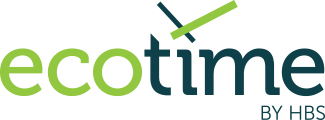Optimize Time Keeping with Electronic and Web Employee Time Clocks
Ecotime Benefits

Electronic and Web Options

Offline Capabilities

Head Count

Accuracy

Durability
Our electronic employee time clocks are designed for years of service in harsh commercial environments.

Customer Service
Request a Quote Today!
Experience what sets Ecotime by HBS above any other time and attendance software by contacting one of our experienced staff today!
Key Features of Ecotime Wall-Mounted Time Clocks
Multiple Power Options
You have the option to power clocks via an electrical outlet, Power over Ethernet (PoE), and battery backup for uninterrupted use. With this flexibility, you can ensure your time clocks are always operational.
Management Software
Ecotime time clock software enables you to easily manage electronic time clocks and control the flow of data. The software also allows you to control clock functionality.
Low Maintenance
Our electronic time clocks are easy to roll out, configure and maintain, and they’re backed by HBS’s industry-leading customer service to provide you with assistance if issues arise.
Key Features of Ecotime Web Clocks
No Physical Limitations
Ecotime’s Web Clock gives you all the functionality of our electronic time clocks without requiring employees to punch in on a centralized wall-mounted time clock – all they need is a web browser.
Expanded Data Capture Capabilities
In addition to clock-ins and clock-outs, Web Clock can capture additional information, including time spent on different jobs or tasks and other data for accurate accounting. Users can access many features of the Ecotime system.
User-Friendly Features
Ecotime’s Web Clock makes clocking in and out fast and easy, with features such as single sign-on.
Employee Time Clocks - FAQ
In today’s fast-paced business environment, efficiency and accuracy are paramount, particularly when it comes to managing finances and human resources. One breakthrough tool modern businesses are increasingly integrating into their operations is automatic time capture technology. This innovative tool simplifies the payroll process in several key ways, making it an indispensable asset for companies looking to streamline their workflows and eliminate errors.
Automatic time capture systems replace manual time tracking methods, which are often riddled with inaccuracies due to human error or deliberate time theft. By automatically recording employees’ work hours through digital means, these systems ensure the data collected is precise and unalterable. This level of accuracy significantly reduces the likelihood of payroll discrepancies, which can be costly and time-consuming to rectify. Furthermore, because the data is collected and processed digitally, there is a dramatic reduction in the administrative workload involved in preparing payroll. This allows staff to focus on more strategic tasks, improving overall productivity.
Beyond simplifying the data collection process, automatic time capture systems offer a comprehensive view of labor costs in real-time. Managers can easily monitor work hours, overtime, and absences without having to sift through piles of timesheets or cross-reference multiple digital platforms. This real-time visibility facilitates more informed decision-making regarding staffing and budget allocations, enabling businesses to optimize their labor costs more effectively. By streamlining these complex processes, automatic time capture systems not only enhance payroll efficiency but also empower businesses to manage their resources more judiciously.
In the bustling landscape of modern work environments, self-service time reporting emerges as a beacon of autonomy for employees. One standout advantage of adopting such employee time clocks is the unparalleled flexibility it affords. Gone are the days when workers had to painstakingly align their schedules with managerial availabilities just to log hours or rectify discrepancies. Now, with a few taps on their devices, employees can effortlessly manage their time records, anytime and from anywhere. This freedom to report and review work hours at their convenience not only reduces stress but significantly enhances their work-life balance.
Another benefit that employees can look forward to with self-service time reporting systems is the heightened accuracy and transparency in their work records. Traditionally, the manual entry of time sheets was fraught with human errors and inefficiencies, often leading to under or overestimations of work hours. By contrast, self-service models leverage technology to minimize these inaccuracies, ensuring that employees’ work hours are recorded with precision. This is critical not just for their peace of mind but also for fostering a culture of trust within the organization. Employees gain visibility into their time records and, by extension, a clearer understanding of their contributions and compensations.
- Flexibility in managing work hours
- Improved work-life balance
- Decreased stress
- Accuracy in time records
- Increased transparency and trust
Beyond these, the simplicity and user-friendly nature of these systems cannot be overstated. Employees no longer have to navigate the labyrinthine processes that characterized traditional time reporting methods. Instead, they find themselves empowered by intuitive platforms that demystify time management, thereby fostering a more productive and satisfied workforce. Through this lens, it’s evident that self-service time reporting doesn’t just benefit the employees; it’s a catalyst for creating more engaging and efficient work environments.
Calculating overtime for employees can be a tedious and time-consuming task for many businesses. It requires careful tracking of employee hours worked and the application of complex overtime rules. To streamline this process, many businesses have turned to using scheduled hours to calculate overtime. Below we’ll explore why using scheduled hours to calculate overtime is important for businesses.
1. Consistency in Payroll Processing
Using scheduled hours to calculate overtime provides consistency in payroll processing. With a set schedule, employees know what to expect in terms of their work hours and employers can accurately calculate their pay. This also makes it easier to track hours and ensure that employees are being compensated fairly.
2. Compliance with Labor Laws
Calculating overtime correctly is essential for employers to maintain compliance with labor laws. Failure to comply with overtime rules can result in significant penalties and legal issues. By using scheduled hours to calculate overtime, employers can ensure that they are following the appropriate regulations and paying their employees fairly.
3. Avoiding Errors in Payroll Processing
Manual calculation of overtime can lead to errors in payroll processing. These errors can result in overpayment or underpayment of employees, which can lead to dissatisfaction and legal disputes. Using scheduled hours to calculate overtime can help eliminate errors in payroll processing and ensure that employees are paid accurately.
4. Easy Tracking of Employee Hours
Using scheduled hours to calculate overtime makes it easier to track employee hours. Employers can easily record scheduled hours and any changes to the schedule, making it simpler to track hours worked and calculate overtime. This also helps to ensure that employees are not working too many hours, which can lead to burnout and decreased productivity.
Finally, using scheduled hours to calculate overtime is essential for businesses. It ensures consistency in payroll processing, helps maintain compliance with labor laws, avoids errors in payroll processing, and makes it easier to track employee hours. By implementing this practice, employers can save time and reduce the risk of legal disputes, while providing their employees with accurate and fair compensation.
Secure employee time clocks have revolutionized the way businesses manage and monitor employee time and attendance. With an array of biometric solutions and smart time-tracking software, these systems offer a formidable defense against two of the most common workplace issues – time theft and buddy punching. Essentially, time theft, the act of employees misreporting their working hours, and buddy punching, where one employee clocks in on behalf of another, can significantly dent a company’s financial health.
Biometric systems like fingerprint scanners or facial recognition technology are at the forefront of tackling these challenges. By tying clock-ins to unique physical attributes, it becomes nearly impossible for one employee to clock in as another, directly addressing and eliminating buddy punching. Additionally, the precision of biometric employee time clocks means that the exact time of each clock-in and clock-out is recorded, making it difficult for employees to claim unworked hours as worked. These technologies ensure that employee attendance data is both accurate and verifiable, leading to fairer labor cost management and distribution.
Moreover, smart time-tracking software equipped with secure clock-ins brings transparency and accountability into the workplace. Employees are mindful of the precision and reliability of these systems, fostering a culture of honesty and integrity. For employers, the detailed and accurate data provided by these systems simplifies payroll processing and can highlight patterns or trends in attendance that may need addressing. Beyond just monitoring, these systems also support compliance with labor laws and can be customized to suit varying business needs, making them a versatile tool in the modern workplace’s arsenal against time theft and buddy punching.
Harnessing real-time employee time clock data for workforce management transforms how organizations approach their most important asset – their employees. By tapping into the live pulse of workplace operations, managers can make informed decisions, optimizing both employee satisfaction and organizational performance. This dynamic approach pivots on the ability to collect, analyze, and act upon data instantaneously, marking a significant shift from traditional methods that often rely on outdated information.
Real-time data facilitates a thorough understanding of various factors affecting workforce efficiency, including attendance patterns, task completion rates, and more nuanced aspects such as employee morale. This wealth of information enables managers to identify trends, predict potential issues, and implement solutions before minor setbacks escalate into significant problems. For instance, noticing a pattern of declining productivity in a department could prompt a swift investigation, leading to the discovery of underlying issues such as overwork or dwindling motivation.
To harness real-time data effectively:
- Analyze attendance and workload data from employee time clocks to ensure equitable distribution of tasks, reducing burnout while increasing job satisfaction.
- Monitor real-time performance metrics to recognize and reward high achievers, fostering a culture of acknowledgment and motivation.
- Implement feedback mechanisms that allow for immediate responses to employee concerns, creating a responsive and inclusive environment.
In essence, leveraging real-time data in workforce management equips leaders with the tools necessary to foster a thriving workplace. By actively responding to the ever-changing dynamics within their teams, managers can cultivate an environment where both employee satisfaction and productivity soar, setting a new standard for operational excellence.






